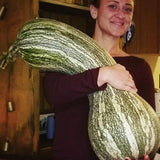Green Striped Cushaw Squash
Cucurbita mixta
Also known as "Sweet Potato Pumpkin," this mildly sweet and meaty squash is made into as pie filling, cushaw butter, puddings, and simply roasted. Many 10-20 pound striped, crookneck fruits grow on hardy, heat-tolerant, and borer-resistant vines. This variety was domesticated thousands of years ago in tropical Central America, and are beloved in several southwestern Indigenous nations, Louisiana, much of the southeast, and southern Appalachia. Truelove Seeds apprentice Amirah Mitchell's great grandfather in North Carolina loved this squash as well, and she now stewards this ancestral squash to make cushaw butter and pies. Michael Twitty, author of The Cooking Gene, notes that "cushaws produced from the late summer into the late fall, taking the place of sweet potatoes while they were out of season". To read more about the history and uses of the green striped cushaw, see the Slow Food Ark of Taste.
Our seed was grown by Amirah at Urban Tree Connection, as well as by our friend Elizabeth Andrews in Ashford, Connecticut. At Urban Tree Connection, we learned that there were Butternut Squash (C. moschata) growing a couple hundred feet away, and despite being a different species, there is a small chance that they could have hybridized and some plants and their fruits may have traits of butternut.
Also known as: Striped Crookneck, Striped Cushaw, Sweet Potato Pumpkin.
Days to maturity: 95-105
Seeds per pack: 20
Germination rate: 98% on 03/17/2025
Planting / harvesting notes
Direct sow in warm soil after the last frost, or seed indoors 2-3 weeks beforehand and transplant. Plant 3 seeds per hill spaced several feet apart, or seed in rows, one plant every 2-3 feet. Vines grow fairly long, so allow them space to sprawl. If grown in corn, you may need to train them so they won't pull it down! Avoid downy mildew by watering only at the base of the plant (not on the leaves!). Harvest when the stem begins to turn brown and woody and the fruit becomes hard, leaving a couple/few inches of stem. Cure in a dry or sunny place for a week, and then store in a cool (45-50 degrees) room for up to 4 months (however, keep an eye on it and use it at earliest sign of softening if not before).
Seed keeping notes
Squash is insect pollinated and requires about 1/2 a mile of isolation from other varieties of the same species, which in this case is C. mixta. The seeds will be fully mature on any squash when the stem of the fruit has turned brown and woody, so when you eat your squash, the seeds should also be ready for harvest. Separate the seeds from the flesh, rinse them, and dry them on a screen or paper product away from direct sunlight in a ventilated place. The plumpest and hardest seeds will be most viable.




